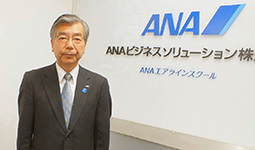Home > Highlighting JAPAN > Highlighting Japan January 2017 > Safety First
Highlighting JAPAN


Maintaining High Standards
For Japan’s largest domestic and international airline, communication is the key to reducing human errors and preventing accidents.
Herbert William Heinrich, an American, introduced an empirical rule in his 1931 book, Industrial Accident Prevention: A Scientific Approach, according to which for each major accident there are 29 accidents with minor injuries and 300 accidents causing no injuries. This has become widely known as Heinrich's Theory and still forms a basis for considering measures for preventing accident occurrence in all industries.
In the airline industry, where safety is paramount, airlines and aircraft manufacturers around the world strive to prevent accidents by implementing a variety of safety measures. Among them, All Nippon Airways (ANA) is one of those that have built unique countermeasures for reducing human errors.
“Based on the premise that the human race inherently causes errors, we train ourselves constantly,” says Shiro Miyazaki, a lecturer on human error measurements at ANA Business Solutions, who has worked as an engineer for many years in ANA. “In preventing accidents, it is important to immediately share experiences of occurrences of near-misses among employees. In order to promote this sharing of experiences, ANA provides an ideal environment that enables everyone to speak up freely whenever he or she notices that something is not right.”
ANA has a mission critical system for the central management of all business operations, and has built a number of information sharing systems under it. The system of the maintenance division for example enables engineers to freely transmit what they notice at maintenance work sites. These opinions are compiled in databases and shared by all aircraft maintenance technicians, helping to prevent the occurrence of human errors. In addition, all the tools are embedded with integrated circuit chips so that even if they are lost in an aircraft, sensors can find them. Sensors are also installed in the gates to the aircraft maintenance facilities, and strict checking of the numbers of tools is conducted upon access to and from the facilities.
Furthermore, in the maintenance division, engineers in charge personally conduct inspections to take responsibility all the way through to the final confirmation work. This system allows each of them to take responsibility and challenge, and prevents checking errors caused by carelessness, such as the unquestioning belief that “The work was undertaken by that experienced engineer so everything should be OK.” During the last phase of these inspections, “finger pointing and calling” is implemented for the final confirmation. The aircraft maintenance technician in charge points his or her finger at the subject to be confirmed and says “Yoshi!” (OK!) when the confirmation task for the subject is completed. Some data suggest that utilizing the combination of hearing, vision and action in confirmation tasks by “finger pointing and calling” helps decrease error occurrence rates to one-sixth.
A range of systems and training have been developed for the captains and other flight crew and cabin crew members for the purpose of preventing human errors. For example, flight crew members can freely transmit their own experiences of occurrences of near-misses through ECHO (Experience Can Help Others).
Japanese society tends to place greater value on hierarchical relationships. For this reason, there are many cases where people cannot express their opinions in an open manner to their superiors. However, ANA has a culture that allows an auxiliary co-pilot to say immediately to the captain, “Please check it” when he or she notices that something is not right, even if it may be a misconception on his or her part.
“The concept that ‘everyone except oneself is a customer’ reflects the quality management culture unique to ANA. All employees except oneself are respectable internal customers. Good human relations can be established only when there is a lubricant of smooth communications. On this basis, its training focuses on enabling each employee to play a leadership role corresponding to his or her position,” says Miyazaki.
ANA is ranked among the top airlines in the world. According to the World Airline Rating conducted every year by British company Skytrax, ANA was awarded the Certified 5-Star Airline Rating, the highest category quality ranking in the world, for four consecutive years from 2013 until 2016, based on the assessment of staff services throughout the airport and the onboard service environments together with other assessment items. ANA is the only Japanese Certified 5-Star Airline among just nine airlines in the world with this top status.
In addition, ANA has established a partnership with Boeing, the world’s largest aircraft manufacturer. This partnership is symbolized by the Boeing 787, which went into commercial service in 2011. ANA was the launch customer for the Boeing 787 and was deeply involved in the development of the aircraft.
“An airline constantly engaging in maintenance tasks can best understand the operational functions of aircraft. ANA continues to provide information regarding the issues to be improved to manufacturers and develops good aircraft through joint efforts,” says Miyazaki. “Boeing has valued ANA as it has been a vital partner for them throughout the program. We are proud that we have built such a relationship of trust.”
© 2009 Cabinet Office, Government of Japan








